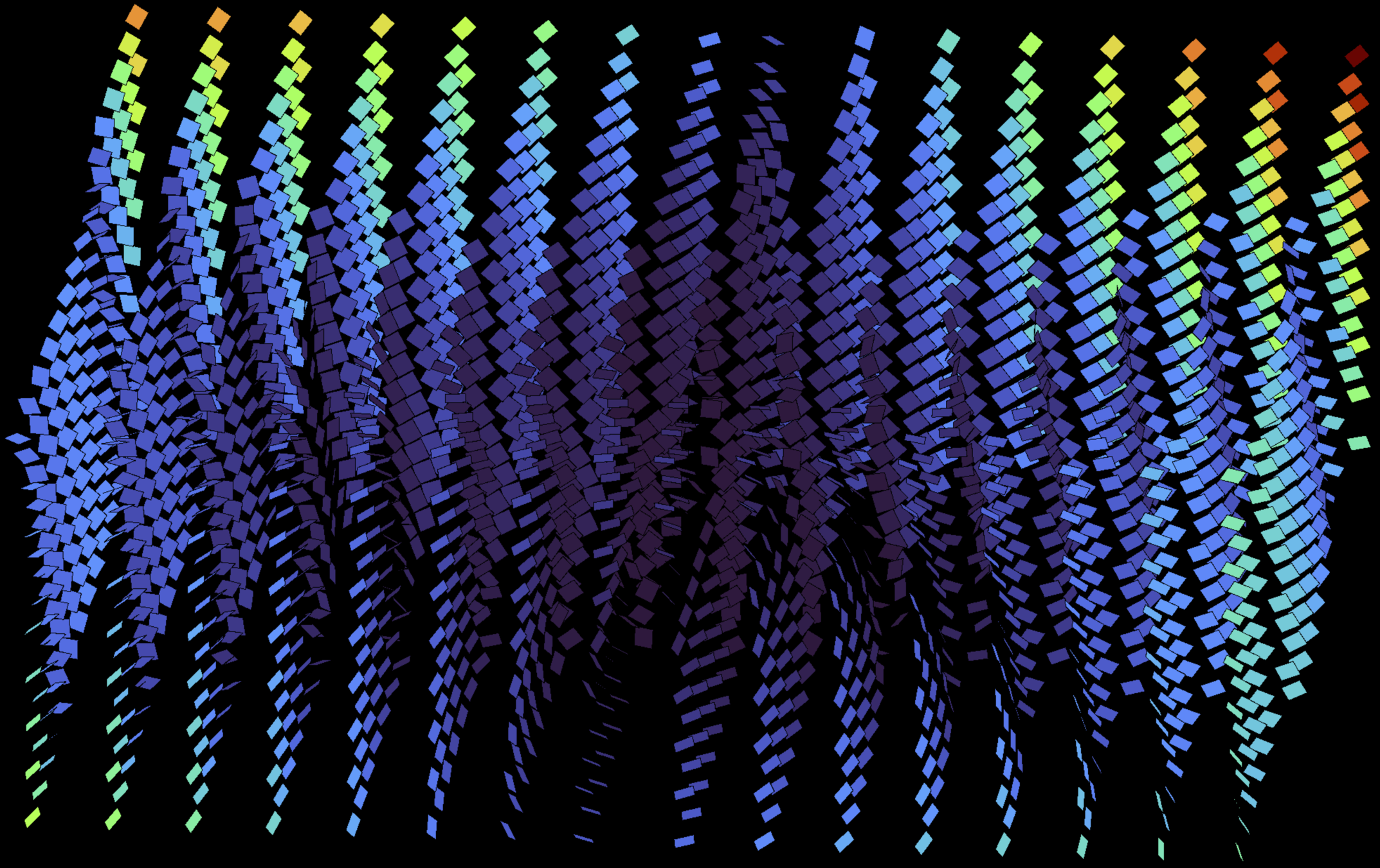Hodge and Gelfand Theory in Clifford Analysis and Tomography
/qipa22
This talk!
Colin Roberts
Colorado State University

Most of what I will talk about today is work of Colin Roberts.
Motivations
Calderón Problem.
Given a Riemannian manifold \((M,g)\) with boundary, determine \(g\) from the Dirichlet-to-Neumann operator \(\Lambda\).
Belishev’s 2D Solution.
On a surface, \(\Lambda\) determines the algebra \(\mathcal{A}(M)\) of holomorphic functions on \(M\), which determines \((M,g)\) up to conformal equivalence.
Clifford Algebras
If \(V\) is a vector space with symmetric bilinear form \(g\), the tensor algebra is
and the associated Clifford algebra is
\(\dim(C\ell(V,g)) = 2^{\dim(V)}\)
Examples
\(\bullet\) \(V = \mathbb{R}^2\), \(g(u,v) = u \cdot v\).
\(\bullet\) \(g = 0\).
\(\bullet\) If \(g\) is non-degenerate, \(C\ell(V,g)\) is called a geometric algebra. Use the notation \(\mathcal{G}_{p,q}:=C\ell(V,g)\), when \(g\) is the standard non-degenerate form of type \((p,q)\).
Gradings
If \(A \in \mathcal{G}_{p,q}\), let \(\langle A\rangle_r \in \mathcal{G}_{p,q}^r\) be the grade-\(r\) part of \(A\).
On homogeneous elements \(A \in \mathcal{G}_{p,q}^r\) and \(B \in \mathcal{G}_{p,q}^s\),
The subset \(\mathcal{G}_{p,q}^+\) of even-graded elements forms a subalgebra, called the spinor algebra.
Examples
- \(\mathcal{G}_{0,2}^+ \simeq \mathbb{C}\): generated by \(1\) and \(e_1e_2\), with \((e_1e_2)^2 = -1\).
- \(\mathcal{G}_{0,3}^+ \simeq \mathbb{H}\): generated by \(1,e_1e_2, e_2e_3, e_3e_1\).
- \(\mathcal{G}_{1,3}^2 \simeq \mathfrak{spin}(1,3)\), the Lie algebra of the Lorentz group.
Multivector Fields
\((M,g)\) smooth, compact, connected, oriented.
Definition.
The geometric algebra bundle over \(M\) is
The multivector fields \(\mathfrak{X}(M)\) are smooth sections of \(\mathcal{G}M\).

Hodge–Dirac Operator
\(g\) induces the Levi–Civita connection \(\nabla\) and covariant derivative \(\nabla_v\) on \(M\), which extend to multivectors.
Definition.
The Hodge–Dirac operator is defined in local coordinates by
For \(A,B \in \mathfrak{X}(M)\), \(\nabla(AB) = \dot{\nabla}\dot{A}B + \dot{\nabla}A\dot{B}\).
\(\nabla^2\) is the Laplace–Beltrami operator.
Examples
- For \(A \in \mathfrak{X}^+(\mathbb{R}^2)\), \(\nabla A = 0\) iff \(A\) is a holomorphic function.
- For \(v \in \mathfrak{X}^1(\R^3)\),
Monogenic Fields
Definition.
The space of monogenic fields \(\mathcal{M}(M) := \ker \nabla\).
Monogenic fields
- can be uniquely continued
- have a Cauchy integral
- have harmonic components
Clifford–Hodge Decomposition
Theorem [Roberts]
The space of multivector fields on \(M\) has the orthogonal decomposition
where the Dirac fields are defined as
Connections to EIT
\(M\) an Ohmic region in \(\mathbb{R}^3\), relate conductivity to \(g\) in the usual way.
Ohm’s Law: \(-\nabla \wedge u = J\)
Conservation: \(\nabla \,\lrcorner\, J=0\)
Define the electric DN operator \(\Lambda_E: t \mathfrak{X}^0(M) \to t\mathfrak{X}^0(M)\) by
where
Magnetic Analog
Define the electric DN operator \(\Lambda_E: t \mathfrak{X}^0(M) \to t\mathfrak{X}^0(M)\) by
where
Define the magnetic DN operator \(\Lambda_B: n \mathfrak{X}^2(M) \to n\mathfrak{X}^2(M)\) by
where
\(A_+ := u+B \in \mathcal{M}(M)\) is a monogenic spinor.
Geometric Generalization
Generalized electric DN operator \(\Lambda_E: t \mathfrak{X}(M) \to t\mathfrak{X}(M)\)
Generalized magnetic DN operator \(\Lambda_B: n \mathfrak{X}(M) \to n\mathfrak{X}(M)\)
where
\(\Lambda_E \times \Lambda_B\) is equivalent to the complete DN operator
[Sharafutdinov–Shonkwiler, 2013]
Spinor DN Operator
Define the spinor DN operator \(\mathcal{J}: \operatorname{tr}\mathfrak{X}^\pm(M) \to \operatorname{tr}\mathfrak{X}^\pm(M)\) by
Scalar part: \(\langle \mathcal{J} \rangle = \Lambda_E + \Lambda_B\).
Theorem [Roberts]
\(\ker \mathcal{J} = \operatorname{tr} \mathcal{M}^\pm(M).\)
Connections to Boundary Control
Building on ideas of Belishev and Vakulenko, define a spinor spectrum \(\mathfrak{M}(M)\) consisting of certain grade-preserving \(\mathcal{G}_{0,n}^+\)-linear maps \(\mathcal{M}^+(M) \to \mathcal{G}_{0,n}^+\).
E.g., point evaluation \(\delta[A_+] = A_+(x_\delta)\).
Theorem [Roberts]
With the weak-\(*\) topology on \(\mathfrak{M}(M)\), the map
is a homeomorphism.
The Gelfand transform \(\widehat{A_+}(\delta) = \delta[A_+]\) is an isometric isomorphism, so \(\mathcal{M}^+(M) \simeq \widehat{\mathcal{M}^+(M)}\).
Questions
- Does the DN map determine \(\operatorname{tr}\mathcal{M}^+(M)\)?
- Relationship between \(\vee \mathcal{M}^+(M)\) and \(\vee \operatorname{tr}\mathcal{M}^+(M)\)?
- Does \(\mathcal{M}^+(M)\) determine the metric on \(M\)?
- Hilbert transform?
Thank you!
References
Colin Roberts, Hodge and Gelfand Theory in Clifford Analysis and Tomography, Ph.D. thesis, Colorado State University, 2022, https://hdl.handle.net/10217/235741
Colin Roberts, A Gelfand transform for spinor fields on embedded Riemannian manifolds, preprint, 2022, arXiv:2203.00118